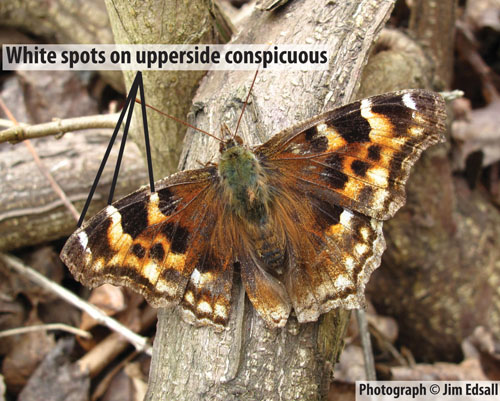Compton Tortiseshell (Roddia vaualbum)
Description: A large orange and brown butterfly. The upperside is rusty brown with large dark spots, a narrow dark submarginal band, and a white spot near the leading edge of both the hind and forewings (some individuals show two or three white spots on the forewing.) This spot plus its larger size will distinguish it from the commas and Question Mark. The underside is mottled greyish-brown, with a small white “v” on the hindwing, similar to the comma mark of the commas. Wingspan: 52 to 73 mm.
Maritime Distribution: Widespread throughout the Maritimes, apparently not recorded on Cape Breton Island. For Atlas results click here.
Provincial Ranks: NB: S3. NS: S1S2. PEI: S1.
Flight Period: Compton Tortoiseshells overwinter as adults, and can be seen flying in April to early June and from late July to early October. There is one generation per year.
Host Plant: Various willows (Salix spp.), alders (Alnus spp.), and poplars (Populus spp.).
Notes: Typically found in boreal forest habitats and in coastal forests, this species is wary and hard to approach. Once disturbed they fly powerfully and erratically and are often counted among the one’s that got away. Adults frequently overwinter in man-made structures like outhouses and garages. They are attracted to carrion, animal droppings, and fermented fruit.


